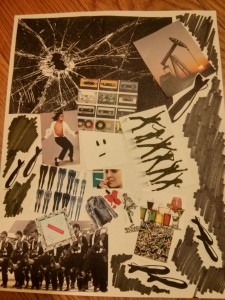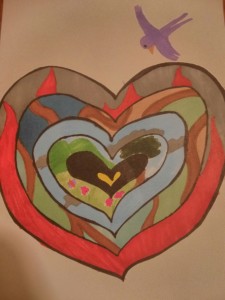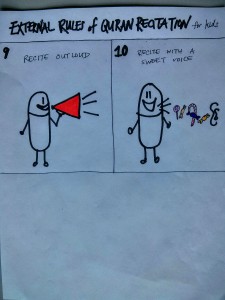Introduction to Creative Exploration
Hello everyone, thanks for visiting my blog, Creative Exploration! I created this blog for the final project assignment for the class, For the Love of God and His Prophet: Religion, Literature, and the Arts in Muslim Cultures. This class is under the Aesthetic and Interpretive Understanding general education department at Harvard College, and it views the religion, Islam, through the lenses of literature, arts, and culture.
This is my first religion class, ever. I am not a religious person, and I have only been minimally exposed to Buddhism and Christianity through my family and friends. So, I was nervous going into this class, and worried that I would have a hard time connecting to the course material. At the beginning, I did have a hard time. The reason why I had not taken up a religion of my own was because I had trouble accepting the fact that one person, God, created everything and is better than any human or creature would ever be. I thought that was very selfish of him to put that in the Bible, and I was finding similar themes of greatness and awe in our readings of the Qur’an (the Islamic religious text). I struggled to understand the course material because I was very skeptical of religion and the idea of God. However, after meeting with Professor Asani, I came out with a better understanding of the course structure and material. He suggested that I look at the material as a cultural exploration where I am trying to understand a way of life, rather than approaching this as a course about religion. This bit of advice is what I have stuck with for the semester and I have come off better educated about Muslim culture. This blog is the culmination of my studies of the Muslim culture, and as a result, my cultural interpretation of the religion of Islam.
From the beginning of the course, Professor Asani had been very clear about using literature and art to contextualize Islam in various cultures, to humanize a religion that has been so dehumanized by current events. I had never before thought about studying religion through an artistic lens before, and I thought it was a fun way to begin my religious studies. Art and literature can be interpreted and appreciated on its own, and when added to the context of a culture, it add meaning to the first impression of an unreligious scholar like me. Art expression is also a safe way to express criticism/skepticism in an ambiguous way, as well as a safe way to explore culture. I believe that it allows the use of everyday objects to introduce an abstract or complicated topic to an audience. I hoped to do the same in my art projects, not only to introduce my interpretation of the course materials to others, but also to better understand the concepts myself. In my blog, Creative Expressions, I have a total of 6 creative art pieces where I try to grapple with understanding the basics of Islamic expression from a nonreligious point of view.
Throughout the course I had been especially fascinated by the ideas of spirituality and mysticism because I had not experienced spirituality in the context of religion. Lucky for me, a lot of the art work and literature we first explored described and expressed the feeling of spirituality. My first blog post is about the influence of Islam in a person’s life from childhood through adulthood, entitled “The Quran and Me” (medium: poetry). Islam, and religion in general, is a very personal affair that develops with the individual as the individual become older. This blog post serves as an outsider’s view (me) on an insider’s view of his own religion. This first post also reflects the importance of the Qur’an in everyday life, and how much devotional time it takes to understanding its meaning. In addition, the sound of the words can have such a strong sentimental meaning to the study of Islam no matter the culture. This is also reflective of how the practice of religion changes with the circumstances in the local context and how growing older will also change your interaction with religion. Islam has been interpreted from various points in history, and that context influences the interpretation. Even in today’s Muslim society, people are trying to reinterpret the Qur’an to include women’s rights and modern twists.
My second blog post continues to explore the Qur’an, but looking at the soundscape it creates rather than just as a religious text. In Muslim cultures, Quranic verses can be heard throughout cities and towns throughout the day. They are often played from buildings as a reminder of the presence of Islam in everyday life. The Qur’an itself is a piece of artwork that was first orally transmitted then transcribed into text. The oral Qur’an, when recited correctly, elicits an emotional response from the reciter and audience. This theme was hard for me to grasp because I did not understand Arabic, so I tried to understand the rules of recitation in the way kids could try to. I created cartoon drawings of suggested rules to follow while reciting the Qur’an, so that I could also easily follow them. This cartoon drawing is also in a sense poking fun of the fact that I couldn’t really comprehend the idea of an oral religion, or the spirituality achieved through hearing and reading the words in a particular manner. However, I hope that after viewing my blog post, viewers would have a better sense on how to build the foundations to incorporating the importance of correct Qur’an recitation into Muslim culture.
I continued to explore mysticism and spirituality in my next two blog posts as well. My third blog post, “Islamic Mosque Décor” is a marker drawing on paper. The symbol of Muslim spirituality is the mosque. All mosque have a set layout with a qibla wall that faces Mecca, a mihrab, and mimbar. However, their designs set them apart. Mosques can be beautifully decorated buildings that have varying Islamic motifs, or they can be simple buildings with no decorations. In designing the mosque and creating the artwork to go in it, the artist finds a connection with God. They also include into their design art that would remind others of God, or simply images that were only meant for God. What is considered to be Islamic art is highly debated, and the argument is whether or not something can be categorized as Islamic art based on cultural contexts or with spirituality alone. This was a really fun coloring exercise for me, and I came away from this understanding that I could appreciate what someone tells me is Islamic art, but as far as understanding how this are evokes spiritual intimacy with God is something I am currently not able to understand.
I finished off my mystical and spiritual exploration by creating “The Seven Hearts” drawing (media: marker on paper). This drawing is based off “The Conference of the Birds,” a poem written by Farid al-Din Attar as a spiritual allegory for the journey Muslims take to get to know God to the fullest. As most poems are, this poem also had ambiguous references, so I focused on the story of the Seven Valleys. The Seven Valleys are hurdles that each Muslim must overcome to reach a level of spirituality where you are able to meet God. I made depictions of what each valley’s challenge was and what the lesson I interpreted each valley concluded with. It helped me visually the journey that each bird took. I chose the shape of a heart because God is seen as the beloved in Muslim piety and spirituality. As a non-religious scholar, the idea that something other than a physical human is the ultimate beloved in life was different for me to comprehend. In general, Muslim spirituality involves weeping for the Beloved, longing for the Beloved, and always seeking to be with the Beloved.
For my last two blog posts I decided to flip from learning about the spirituality of Islam, and focus on the current issues present in the Middle East and Islamic nations. I felt like it was important for me to understand what was going on and how to be a better educated person about my opinions and the media’s opinions. My blog posts are titled “Hidden Resistance” (media: collage) and “Dimensions vs Dichotomies” (media: charcoal). It was mentioned during that class that it would be difficult to understand Muslim culture today without understanding the conflicts that impact the societies. This goes back to the idea that changes with time will affect how people interact with religion. From my personal view, I think that people should be allowed to choose how they live their lives because everyone has many dimensions to their identity. In “Hidden Resistance” I show that although the outer surface may not show it, underneath a given identity is a unique person that should be allowed to express themselves. In “Dimensions vs Dichotomies” I reflect a similar idea, that each person has many dimensions and should not be forced to be categorized into one or two. I feel that more people should think this way more often and be more open minded. These categories that Muslims are now being put in, both in their home countries and in foreign countries, detract from the spirituality of the practice of Islam. I certainly felt this as these last two posts were very different from the first four, and there was little mention of religion in either.
I am really thankful for the opportunity to take this course my last semester in college for a few reasons. 1. I was finally able to explore and gain a better understanding of Islam and religion. 2. I was able to explore religion through art, and be creative this semester. 3. I am coming away from the class, better equipped to make sense of the media and current events. I had a lot of fun making the art for these blog posts, and I hope you enjoy them too.






